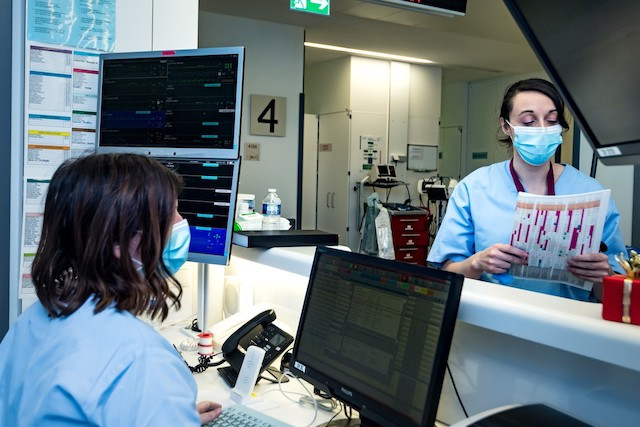There’s an air of relief in the corridors of the Center hospitalier Emile Mayrisch (Chem). “It’s calm today. There are fewer cases at the national level,” says Daniel Cardao, director of the institution.
It’s visible in the emergency room, strangely empty at the start of the morning of Tuesday 19 January. Patients are greeted in the old ambulance hall and triaged between covid and non-covid. Their temperature is taken, blood oxygen levels and blood pressure are checked, before the patients are directed to the green elevator for conventional emergencies, or the red for covid emergencies.
We go up on the second to reach the containment area, installed in the premises of the former pediatrician, on the third floor. There are six covid consultation stations, between which several doctors and nurses are walking.
11 full-time equivalents work in the service. Among them is Gwendoline Mergen, a nurse, who takes a break to speak with us. "The situation for the moment is more stable, we have time to breathe a little,” she confirms. "But it's still complicated, because there are still cases of very sick people."
She remembers the month of November, when things were tenser. “Sometimes we didn't have a place to put people, there were some in the hallways. For those who needed a lot of oxygen, we put bottles in the hallway too." A "stressful" situation, which she says however she is rather used to based on "classic" emergencies.
You can see a testimony of her experience in this video (in French).
From 60 to 15 beds reserved for covid patients in normal care
The Esch-sur-Alzette hospital had 23 so-called “covid” patients during our visit. Three arrived that same morning and were awaiting their test results. 14 were still in normal care and 6 in intensive care, 4 of whom were intubated.
The three “covid suspects” therefore remain on the third floor, in a confined area, where there are eight rooms with airlocks, also accommodating people in normal care. A dedicated scanner has also just been transferred to the area.
The other patients in normal care were placed on the upper floors, where, in terms of staff, 30 beds correspond to 35 full-time equivalents. Here there’s a noticeable change: with four wings of 15 beds each, spread over two levels and reserved for covid patients for months, only one has been welcoming them for a few days. The other three are gradually resuming their traditional orthopedic activities.
In the long corridors, cleaning crews are therefore busy disinfecting everything, while others carry empty beds. Garbage bags are stored here and there. Behind half-open doors, monitors usually hooked up to respirators float above the clean sheets. Others, however, remain closed, sheltering patients. Even under the mask, you can still smell the antiseptic mingled with the medicine, a scent specific to hospitals.
"It will do us good, to return to normality," explains Estelle, a nurse in the covid unit since March. Even if it that doesn’t exclude a step back, in the event of an upsurge in the number of cases. Despite physical and mental fatigue, she found this period "enriching", thanks to moments of solidarity with all the staff.
Intensive care divided in two
At the level of intensive care too, there’s deceleration. Located in the annex, they have just gone from two floors to one. Julie Josef, a nurse, has therefore been resuming her activities in “classic” intensive care for a few days. “It’s a relief. It doesn't feel like we're actually working. We go in, we leave the rooms, without risk, without getting ready,” she says with a smile. This is a change from the 10 minutes necessary to equip themselves prior to entering rooms occupied with patients who have tested positive for covid-19, including the hygiene cap, gown, gloves, glasses, and mask… and this, even in the event of emergency.
The young nurse looks back on what she describes as "stressful": "I was tired. We came home a little demoralised when we saw our patients who were not necessarily doing well. We had a lot of deaths anyway. It weighs on our morale.”
She says she is particularly touched by the age of the patients. “They were the age of my parents, my brother. It’s complicated."
Seeing several of her colleagues infected, especially during the second wave, where patients were no longer systematically intubated and therefore could more easily infect them, also affected her. "It's a little hard to think that we are here to help people, but at the same time, we may also need help afterwards."
But she isn’t claiming victory too early either. “We've changed this service from green zone to red zone twice, and vice-versa. I don't think it's the last time. "
The hospital is always ready to reorganise itself quickly in the event of an upsurge in cases. Thus, in phase 4, it is able to accommodate a maximum of 22 patients in intensive care and 56 people in normal care. €2.7m have been invested by the government for the fitting out of these flexible covid units.
The hospital is now relying on vaccination to keep from going back to the extreme phase. Internally, 592 people have already been vaccinated during the first week of the campaign. Others were lining up on Tuesday to receive their doses. Chem has already received some to treat 975 people and is awaiting its next delivery on 1 February.
This article was originally published on Paperjam.lu and has been translated and edited for Delano.
